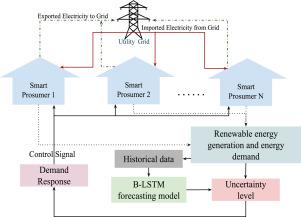Grid-to-prosumer (G2P) interactions: Using bi-directional LSTM techniques to enhance the smart grid network through a demand response scheme
引用次数: 0
Abstract
To solve the issues in the electric power distribution network, oscillations in Electric Power Consumption (EPC) and Renewable Energy Generation (REG) must be considered. EPC and renewable energy resources (RES) are mostly used by prosumers integrated with smart grid. An incentive and dynamic pricing-based Demand Response (DR) can control the supply and demand balance. Uncertainty issues include supply and demand imbalances, EV charging, and natural REG fluctuations. This research study proposes an incentive and dynamic pricing-based DR technique for Distributed Generation and Demand Management (DGDM). This DGDM method considers the two uncertainties: demand and prosumer generation. The DGDM scheme, as proposed in this research article, has a dynamic incentive and penalty scheme. The policy applicability has been enhanced by the Bi-directional Long Short-Term Memory (B-LSTM) model’s predictive capabilities and ability to restrict the prosumers who participated in the DGDM program. The results demonstrate that the proposed DR policy benefits all parties involved, minimizes the electricity tariff and imbalance in supply and demand, and improves system stability while addressing prosumer issues. The proposed DR for prosumers to get a daily incentive of 89.4088 cents and 425.7844 cents reduce the daily electricity tariff.

电网到生产消费者(G2P)交互:使用双向LSTM技术通过需求响应方案增强智能电网网络
为了解决配电网中的振荡问题,必须考虑电力消耗(EPC)和可再生能源发电(REG)的振荡。EPC和可再生能源(RES)主要由与智能电网集成的产消用户使用。基于激励和动态定价的需求响应(DR)可以控制供需平衡。不确定性问题包括供需失衡、电动汽车充电和自然REG波动。本研究提出一种基于激励与动态定价的分布式发电与需求管理(DGDM) DR技术。这种DGDM方法考虑了两个不确定性:需求和产消量。本文提出的DGDM方案具有动态的奖惩机制。双向长短期记忆(B-LSTM)模型的预测能力和对参与DGDM计划的产消者的限制能力增强了策略的适用性。结果表明,提出的DR政策使各方受益,最大限度地减少了电价和供需失衡,并在解决产消问题的同时提高了系统稳定性。建议DR为产消者每天获得89.4088美分的激励,并减少425.7844美分的每日电费。
本文章由计算机程序翻译,如有差异,请以英文原文为准。
求助全文
约1分钟内获得全文
求助全文

 求助内容:
求助内容: 应助结果提醒方式:
应助结果提醒方式:


